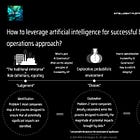🎯 Enterprise AI: leveraging the power of AI, the recap
"Leveraging the power of AI", the recap | Get started with AI | How-to guides and features
If you are reading this, you are likely familiar with the concept of leverage in its digital context: using technology to amplify an effort.
All forms of leverage (code, media campaigns, crowdfunding) that—if deployed with reasonable balance—can keep working after you stop working.
The desire to get more from less is universal. Who wouldn’t want leverage? Why doesn’t everyone have leverage? Because the first part of Archimedes’ statement is more challenging to come by: finding (or building) a firm place to stand.
The physical, mechanical explanation makes perfect sense—you must stand on a firm surface to apply force to the lever to move the thing.
Digitally speaking, this concept is less intuitive—but you still need a firm place to “stand” to direct energy efficiently enough to move something.
Any shifts in our focus would dilute our ability to apply that pressure and significantly reduce our ability to move things.
But why do we want to move things?
To conceptualize this idea, imagine trying to apply downward pressure to many scattered levers simultaneously with your two hands.
In summary, leverage is as much about where you stand as how much force you apply.
Leveraging the power of AI, a 7-part series extracted from the "Enterprise AI toolbox", the curricula:
Part 1: Introduction: why leverage is essential
Through this series, we emphasize the need for a thorough understanding of how value is created within the organization to incorporate AI strategically and the importance of utilizing human capacities to refine business models for enhanced resilience. It is essential to clearly understand how AI aligns with overall business goals and define specific problems and benefits.
Part 2: The real needs
Becoming an AI-first enterprise requires careful planning, strategic execution, and team alignment. The organization's needs must be considered, strategic processes prioritized, and possible challenges addressed. Machine learning tools are advancing rapidly, and businesses must equip themselves with the knowledge and strategies needed to thrive in the data-driven landscape.
Part 3: The use cases
Training LLMs on unstructured data using unlimited computational power can address significant transformations in industries. Unlike previous platform shifts, such as the internet, mobile, and cloud, the market service industries are expected to adopt AI quickly. However, in the competition between traditional information technology environments and growing innovation from startups, incumbents have a significant advantage due to their access to proprietary data.
Part 4: The platform (and the processes)
Even though it is just the beginning of a new era, enterprise AI platforms can empower organizations to leverage AI at scale. They act as central hubs that provide tools and infrastructure to develop and deploy AI applications, improve efficiency and decision-making, and gain a competitive advantage. To fully benefit from AI, businesses need a clear understanding of how it aligns with their overall goals and how it can address specific problems.
Part 5: The challenges
Automated tools and processes are essential to boost development and product teams to deliver business value efficiently. Organizations need to adopt modern architectures and technologies to run well. Leaders and decision-makers must leverage the next two to three years to stay ahead of the curve, innovate, and thrive in an environment of constant change. The questions they should consider are: what are the main challenges they face, which tools should be leveraged to address them, who leads the AI integration, and what is next to expect?
Part 6: The resources
Enterprises should consider investing more in AI technologies and moving from closed-source models to a mix of open-source and closed-source models. There is a growing demand for control and customization of new AI models. This transition emphasizes that AI can provide valuable insights and improve business outcomes, but organizations must understand how to deploy it effectively. Ultimately, AI can help businesses extract knowledge from data to solve complex problems.
Part 7: Unlock your business potential with AI
Enterprise AI involves applying AI techniques like machine learning to the business world. It helps businesses analyze massive amounts of data quickly and comprehensively, uncovering hidden patterns and trends. Repetitive tasks can be automated by AI, freeing up human employees for more strategic work. AI can also analyze data to predict future outcomes and identify the most relevant information. This leads to more accurate decision-making and empowers businesses to make proactive decisions. Overall, Enterprise AI is a game-changer for businesses by providing a powerful toolkit for making smarter decisions.




